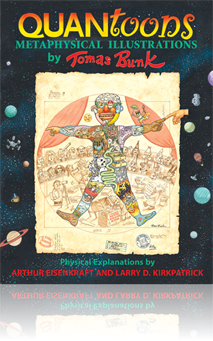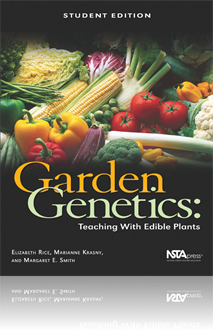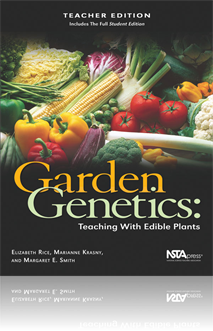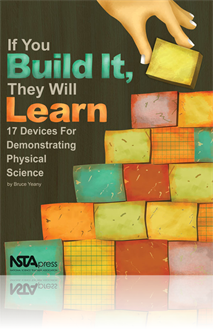All Book Chapters
Book Chapter
The search for the fundamental building blocks in nature has gone on for more than two thousand years. Aristotle felt that all the materials around us were composed of varying quantities of four basic elements—earth, fire, air, and water. In hinds...
Book Chapter
Sources, sinks, and gaussian spheres
Conservation of mass requires that the flow of mass into the volume be equal to the flow of mass out of the volume. Another way of stating this is that the net flow of mass—or flux—through the surface must be zero. This is true unless there are ...
Book Chapter
Archimedes’s law was a great achievement. Everybody knew that an object dropped in water made the water level rise (that is, it displaced some water). But Archimedes was the first to recognize that the amount of water displaced is related to the o...
Book Chapter
Up to now, all of the roller coasters of the world use a continuous track. But that does not restrict our imagination. In this chapter, we imagine that the top portion of the track is removed in a vertical loop, creating the so-called "topless rolle...
Book Chapter
Imagine paddling in a rowboat from one shore to the opposite shore with no current. The trip takes you 15 minutes. If you return to the river and venture across again, paddling to the opposite shore with the same strokes, but with a stiff current dra...
Book Chapter
It Skips a Generation: Traits, Genes, and Crosses (Student Edition)
Long before they understood why the strategy worked, farmers knew how to crossbreed plants to obtain more desirable traits. Even today, a farmer who knows nothing about genetics can tell you that when a blue type of corn crosses with a yellow one, t...
Book Chapter
It Skips a Generation: Traits, Genes, and Crosses (Teacher Edition)
Many of the early discoveries in genetics occured in plants. Plants have a few special characteristics that make them ideal for studying genetics. From one known cross, many genetically similar "siblings" are produced. Building from Gregor Mendel's c...
Book Chapter
Bitterness and Non-Bitterness in Cucumbers: A Story of Mutation (Teacher Edition)
In this chapter, students explore the history of the bitter gene in cucumbers, which was found in a genebank and traded internationally between cucumber breeders. The students then explore transcription, translation, and the DNA basis for different t...
Book Chapter
Survival Strategies (Teacher Edition)
This chapter focuses on ecological principles of plant defenses and insect adaptations to these defenses. Insects either are generalists, often deterred by plant chemical defense compounds, or they are specialists that are attracted to the defense co...
Book Chapter
Domestication: Evolving Toward Home (Teacher Edition)
This chapter explores the concept of domestication and the changes that occur in plants as they transition from wild to cultivated. Domestication is a form of evolution driven by artificial selection rather than natural selection. Two theories of evo...
Book Chapter
The Risks of Improvement: Genetic Uniformity and an Epidemic (Teacher Edition)
This chapter explores the role of genetic diversity in crops. Using hybrid corn as an example, it discusses selection—the genetic narrowing that accompanies gains in traits like yield and disease resistance—and the ecological and evolutionary con...
Book Chapter
Genetic Engineering (Teacher Edition)
This chapter focuses on genetically engineered foods. Bt corn has bacterial genes that encode a protein toxic to many insects. Therefore the corn plant makes its own pesticide. This chapter explores the DNA basis for this genetically engineered plant...
Book Chapter
Sweet Genes in Corn (Teacher Edition)
This chapter begins with consideration of sugars made by the plant during photosynthesis and the movement of those sugars within the plant by diffusion along concentration gradients and by other processes. By exploring the genetic basis of sweet corn...
Book Chapter
Centers of Diversity (Teacher Edition)
This chapter discusses genetic diversity of food plants in the context of the geographic regions from which they originate. The center of origin is the site where the plant was domesticated. The center of diversity is the site where maximum genetic d...
Book Chapter
Quantitative Traits (Teacher Edition)
This chapter begins with single-gene Mendelian traits and compares them to quantitative traits where many genes are involved in determining phenotype. Quantitative trait loci (QTL) studies use molecular markers to pinpoint which sections of DNA are a...
Book Chapter
Bitterness and Non-Bitterness in Cucumbers: A Story of Mutation (Student Edition)
The bitterness of cucumbers is caused by a protein called cucurbitacin. The protein is found in the stems and leaves of many cucumber plants and this is why some people remove the skin and seeds before eating them. The objective of this activity is t...
Book Chapter
Survival Strategies (Student Edition)
Plants are part of complex ecosystems. They must defend themselves from predators. They also must compete with other plants for light, soil, nutrients, and water. Over time, plants have evolved many strategies for defense and competition. In this cha...
Book Chapter
Domestication: Evolving Toward Home (Student Edition)
Domestication is literally the process of bringing an organism—animal or plant—into the home. It's easy to see the evolution from wild wolf to docile dog as domestication. A domesticated plant is one that is dependent on humans for its survival,...
Book Chapter
The Risks of Improvement: Genetic Uniformity and an Epidemic (Student Edition)
In 1970, an epidemic swept through corn crops in the United States. The farmers alleged that the seed companies had behaved irresponsibility in releasing corn varieties that all had the same gene for T-cytoplasm, and that they should be financially r...
Book Chapter
Genetic Engineering (Student Edition)
Genetically engineered crops cross boundaries that traditional crops do not and pose new and challenging regulatory issues. In the United States, a number of government agencies regulate food, plants, pesticides, and agriculture. Who regulates a plan...
Book Chapter
Sweet Genes in Corn (Student Edition)
One of the joys of summer is sweet, fresh, crisp corn on the cob. Most corn is starchy and usually does not taste sweet. Why isn't corn on the cob starchy? What makes sweet corn sweet? Find the answers in this chapter by designing an experiment to te...
Book Chapter
Centers of Diversity (Student Edition)
What country do you think is the origin of the tomato? In this chapter, tables and graphs are used to understand the relationship between food plants and the biomes they originated in. Plant centers of origin are related to the ecology of geographic ...
Book Chapter
Quantitative Traits (Student Edition)
This chapter focuses on Quantitative trait loci (QTL) studies—a way of investigating quantitative traits where many genes have an effect on a trait. The studies help plant breeders find the genes involved in quantitative traits that are controlled...
Book Chapter
Galileo's track is made from one long continuous rail that joins two different angled ramps together. The first ramp has a short, steep slope. After a ball rolls down the first ramp, it will then roll up a longer gently sloping part of the track on t...
Book Chapter
In the demonstration in this chapter, a person holds a large foam board and a small brass weight to compare their respective weights. After hefting both objects for a few moments, the person is asked to determine which is heavier. The obvious answer ...
Book Chapter
This chapter features small wooden or cardboard boxes that hang about 5 feet from the ceiling on a short length of string. A second string comes out of the bottom of the boxes. The purpose of the boxes is not immediately clear because the inner worki...
Book Chapter
Blowing up a balloon inside a bottle is difficult if there is no place for the air to be displaced. Once a balloon is blown up inside the bottle, the balloon remains blown up even with the mouth of the balloon wide open. The project in this chapter i...
Book Chapter
In this chapter, a board is set up with three surfaces. The students' hands compare the relative temperature of the surfaces on the board, and the board prompts students to investigate by asking them to determine which surface is coldest. After placi...
Book Chapter
In this chapter, the words "What color is inside?" appear around a hole on top of a can. The outside is multicolored, indicating that any of a number of colors could be inside. If students look through the hole, it appears that the inside is painted ...
Book Chapter
The device in this chapter shows how a thermostat works by turning a lightbulb on and off as the thermostat responds to the heat of the bulb. It can use a gum wrapper or a strip made from paper and aluminum foil to act as a thermostat mechanism. It b...
Book Chapter
This chapter focuses on the use of some very simple materials to produce an electric motor with which to demonstrate the principles of magnetism. A variation of the simple motor replaces the usual ceramic magnet with a coil of wire to form an electro...
Book Chapter
The principle of a lightbulb can be demonstrated without the danger of creating a vacuum inside a glass jar. One of the difficulties in demonstrating a lightbulb centers on the removal of air from the chamber using a vacuum pump. The device in this c...
Book Chapter
Tops are ancient toys that have been spinning around for thousands of years. Their movement—fascinating to watch—appeals to the child in all of us, and the action and the study of tops appeal to a wide range of age groups. Tops can be used for a ...
Book Chapter
Newton's first law of motion describes the resistance of an object to change in the speed and direction of its motion. The law also holds that objects will resist being put into motion. This concept is described as inertia. This free selection fro...
Book Chapter
Examples of resonance can be shown by using a variety of pendulum demonstrations. This chapter features a coupled pendulum and a Wilberforce pendulum. After observing the motion of the coupled pendulums or the Wilberforce pendulum, students can draw ...
Book Chapter
Hero of Alexandria, in about 62 AD, demonstrated that a small amount of water could be lifted to a point higher than its origin. This apparently contradicts that water can rise only to its own level. In this chapter, find out how a few soda bottles, ...
Book Chapter
String racers are an effective way to demonstrate Newton's third law. In this chapter, the instructions give plans for two types of string racers—the simple balloon racers that are quick and easy to build and a rubber band-powered propeller design ...
Book Chapter
The solar motor is an excellent way of demonstrating one method of changing solar energy directly into motion. For students to understand its operation, they need to understand some basic concepts. One is that matter can contract or expand due to tem...
Book Chapter
In this chapter, find out what a can of soda would feel like on other planets by altering the contents of several containers to simulate the change in surface gravity according to the various planets. This set of cans and a few other simple props can...
Book Chapter
This chapter provides the opportunity for students to observe the breakfast box sitting in plain view on a shelf, table, window ledge or in any other position that is remote enough to keep anyone from accidentally bumping against it. The box is unusu...






